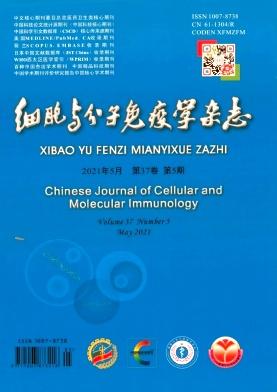【龙胆苦苷通过调控肝星状细胞MIF-SPP1信号通路预防巨噬细胞介导的肝纤维化机制研究】。
摘要
目的探讨龙胆苦苷(gentiopicroside, GPS)通过调节肝星状细胞巨噬细胞迁移抑制因子(MIF)分泌磷酸化蛋白1 (SPP1)信号通路预防巨噬细胞介导的肝纤维化的机制。方法将LX-2细胞分为对照组、转化生长因子β(TGF-β)组和TGF-β联合GPS(25、50、100、150 μmol/mL)组。EDU法检测细胞增殖,TranswellTM法检测细胞侵袭,Western blot法检测α-平滑肌肌动蛋白(α-SMA)和I型胶原蛋白(COL1A1)的表达。采用m1型巨噬细胞条件培养基(M1-CM)处理TGF-β组和TGF-β联合GPS组LX-2细胞。检测细胞上清液中诱导型一氧化氮合酶(iNOS)和精氨酸酶1 (Arg1)的浓度,细胞增殖、侵袭能力以及α-SMA和COL1A1的表达。进行生物信息学分析以确定GPS、肝纤维化和巨噬细胞相关基因的目标交叉点。通过药物亲和反应靶稳定性(dart)实验和Western blot验证GPS对MIF的调控作用。将LX-2细胞分为对照组、TGF-β组、TGF-β联合M2-CM组、TGF-β和e- nc联合M2-CM组、TGF-β和e- mif联合M2-CM组,分析细胞上清中iNOS和Arg1的浓度、细胞增殖、侵袭、α-SMA和COL1A1表达的变化。将LX-2细胞分为对照组、TGF-β组、TGF-β联合oe-NC组、TGF-β联合oe-MIF组、TGF-β和oe-MIF联合GPS组,Western blot检测MIF和SPP1蛋白的表达。建立肝纤维化大鼠模型,探讨GPS对肝纤维化的体内治疗作用。结果与对照组比较,TGF-β组LX-2细胞增殖和侵袭能力增强,α-SMA和COL1A1蛋白表达增强。GPS干预可抑制TGF-β条件下LX-2细胞的增殖和侵袭,降低α-SMA和COL1A1的表达。与对照组比较,TGF-β组细胞上清液中iNOS浓度上调,Arg1浓度降低。M1-CM处理在TGF-β干预的基础上,进一步提高iNOS浓度,降低Arg1浓度,促进细胞增殖和侵袭,上调α-SMA和COL1A1的表达。然而,GPS可以逆转M1-CM干预的效果。生物信息学分析显示MIF是GPS、肝纤维化和巨噬细胞相关基因的靶点交叉点之一,GPS可以靶向并抑制其表达。与TGF-β组比较,M2-CM干预后,细胞上清中iNOS浓度降低,Arg1浓度升高,LX-2细胞的增殖和侵袭能力降低,α-SMA和COL1A1表达减弱。然而,MIF的过表达逆转了M2-CM干预的效果。Western blot结果显示,与对照组相比,TGF-β组MIF和SPP1蛋白表达增强。过表达MIF进一步增强了MIF和SPP1的表达,而GPS干预抑制了MIF和SPP1的表达。动物实验中,GPS干预治疗可减轻肝纤维化大鼠的肝损伤,抑制肝组织中MIF、SPP1以及α-SMA、COL1A1的表达。结论GPS可能通过抑制肝星状细胞MIF-SPP1信号通路预防巨噬细胞介导的肝纤维化。Objective To explore the mechanism by which gentiopicroside (GPS) prevents macrophage-mediated hepatic fibrosis by regulating the macrophage migration inhibitory factor (MIF)-secreted phosphoprotein 1 (SPP1) signaling pathway in hepatic stellate cells. Methods LX-2 cells were divided into control group, transforming growth factor β(TGF-β) group, and TGF-β combined with GPS (25, 50, 100, 150 μmol/mL) groups. Cell proliferation was detected by EDU assay, cell invasion was assessed by TranswellTM assay, and the protein expressions of α-smooth muscle actin (α-SMA) and type I collagen (COL1A1) were measured by Western blot. M1-type macrophage-conditioned medium (M1-CM) was used to treat LX-2 cells in the TGF-β group and TGF-β combined with GPS group. The concentrations of inducible nitric oxide synthase (iNOS) and arginase 1 (Arg1) in the cell supernatant, as well as cell proliferation, invasion ability, and the expressions of α-SMA and COL1A1 were detected. Bioinformatics analysis was performed to identify the target intersections of GPS, hepatic fibrosis, and macrophage-related genes. Drug affinity responsive target stability (DARTS) experiments and Western blot were used to verify the regulatory effect of GPS on MIF. Furthermore, LX-2 cells were divided into control group, TGF-β group, TGF-β combined with M2-CM group, TGF-β and oe-NC combined with M2-CM group, and TGF-β and oe-MIF combined with M2-CM group to analyze the concentrations of iNOS and Arg1 in the cell supernatant, as well as changes in cell proliferation, invasion, and the expressions of α-SMA and COL1A1. LX-2 cells were also divided into control group, TGF-β group, TGF-β combined with oe-NC group, TGF-β combined with oe-MIF group, and TGF-β and oe-MIF combined with GPS group to determine the protein expressions of MIF and SPP1 by Western blot. A rat model of hepatic fibrosis was constructed to explore the potential therapeutic effects of GPS on hepatic fibrosis in vivo. Results Compared with the control group, the proliferation and invasion abilities of LX-2 cells in the TGF-β group were increased, and the protein expressions of α-SMA and COL1A1 were enhanced. GPS intervention inhibited the proliferation and invasion of LX-2 cells under TGF-β conditions and reduced the expressions of α-SMA and COL1A1. Compared with the control group, the concentration of iNOS in the cell supernatant of the TGF-β group was upregulated, while the concentration of Arg1 was decreased. M1-CM treatment further increased the concentration of iNOS, decreased the concentration of Arg1, and promoted cell proliferation and invasion, as well as upregulated the expressions of α-SMA and COL1A1 on the basis of TGF-β intervention. However, GPS could reverse the effects of M1-CM intervention. Bioinformatics analysis revealed that MIF was one of the target intersections of GPS, hepatic fibrosis, and macrophage-related genes, and GPS could target and inhibit its expression. Compared with the TGF-β group, after M2-CM intervention, the concentration of iNOS in the cell supernatant decreased, the concentration of Arg1 increased, the proliferation and invasion abilities of LX-2 cells were reduced, and the expressions of α-SMA and COL1A1 were weakened. However, overexpression of MIF reversed the effects of M2-CM intervention. Western blot results showed that compared with the control group, the protein expressions of MIF and SPP1 were enhanced in the TGF-β group. Overexpression of MIF further enhanced the expressions of MIF and SPP1, while GPS intervention inhibited the expressions of MIF and SPP1. In the animal experiment, GPS intervention treatment alleviated liver injury in rats with hepatic fibrosis and inhibited the expressions of MIF and SPP1, as well as α-SMA and COL1A1 in liver tissue. Conclusion GPS may prevent macrophage-mediated hepatic fibrosis by inhibiting the MIF-SPP1 signaling pathway in hepatic stellate cells.

 求助内容:
求助内容: 应助结果提醒方式:
应助结果提醒方式:


